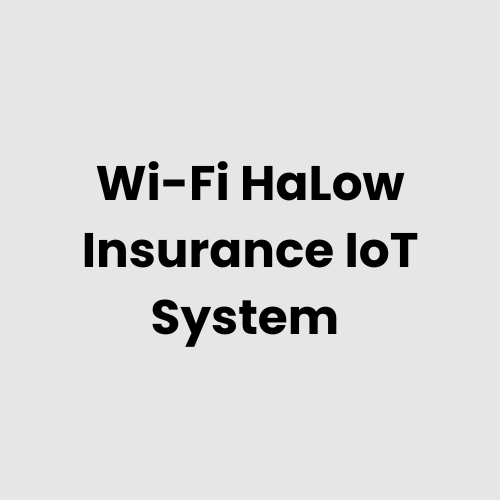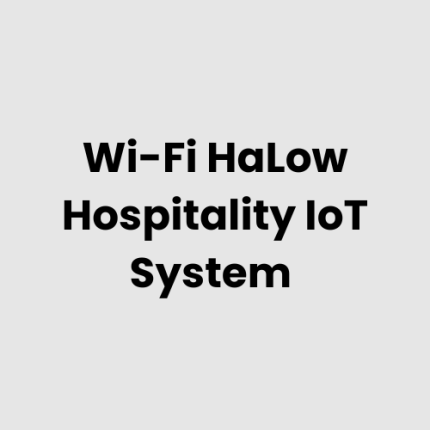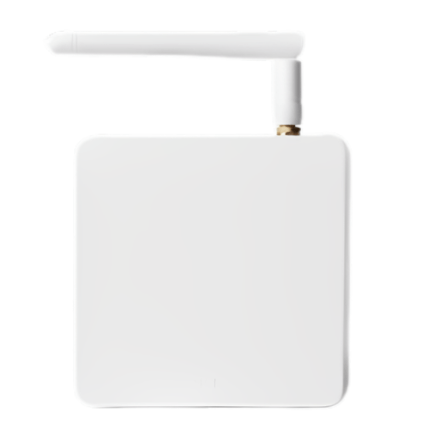Description
Technical Architecture of Wi-Fi HaLow Enabled Insurance IoT System
The Wi-Fi HaLow Enabled Insurance IoT System from GAO Tek Inc. leverages cutting-edge wireless technology to transform the insurance industry, providing real-time data monitoring, risk assessment, and automated claims processing. The system’s technical architecture is composed of several key layers:
- Data Collection Layer:
a. This layer includes IoT devices and sensors that gather critical data for risk assessment. These sensors monitor conditions such as property damage, weather conditions, driver behavior (for telematics), security system status (for home insurance), and more.
b. Data is captured in real-time and transmitted via Wi-Fi HaLow, ensuring low power consumption and long-range connectivity. - Communication Layer (Wi-Fi HaLow):
a. Wi-Fi HaLow provides the backbone for communication between remote devices and the central hub, offering robust connectivity over extended distances. This low-power, long-range Wi-Fi standard is ideal for connecting devices spread across large properties or vehicles in remote locations. - Edge Processing Layer:
a. Data is pre-processed at the edge to minimize latency. For instance, telematics devices can perform initial processing on driving behavior or safety data and send only relevant information to the central system.
b. This layer is crucial for ensuring quick actions like triggering alerts for hazardous conditions (e.g., fire detection, flooding) or adjusting insurance premiums based on real-time risk analysis. - Centralized Data Storage and Analysis:
a. The core data management system aggregates data from all connected devices. It performs detailed analytics such as risk profiling, claims analysis, and fraud detection.
b. AI and machine learning algorithms can also be integrated to predict future risks, helping insurers proactively adjust policies. - User Interface Layer:
a. Insurers and customers interact with the system through web-based dashboards or mobile apps. This interface allows insurers to monitor risk conditions in real time, automate claims processing, and issue policies based on the latest data.
b. Customers can view real-time data related to their coverage, report claims, and receive notifications about potential risks.
Hardware of Wi-Fi HaLow Enabled Insurance IoT System
The hardware components of the Wi-Fi HaLow Enabled Insurance IoT System are optimized for use in both residential and commercial environments, ensuring seamless data collection and communication. Key hardware components include:
- IoT Sensors and Devices:
a. Telematics devices for tracking vehicle behavior, speed, and location.
b. Environmental sensors for monitoring home conditions such as temperature, humidity, and air quality.
c. Surveillance and security devices, including cameras and motion detectors for risk monitoring (e.g., fire, theft).
d. Wearables for health and accident monitoring, especially in health insurance applications. - Wi-Fi HaLow Modules:
a. These communication modules enable IoT devices to transmit data over long distances while using low energy, making them ideal for applications requiring extensive coverage, such as large commercial properties or vehicles. - Edge Devices:
a. Local edge devices that perform initial data processing and decision-making. These can be deployed in critical locations, such as vehicles or buildings, and work in conjunction with sensors to process data and make real-time adjustments. - Centralized Servers:
a. Servers that aggregate and store collected data from various IoT devices, providing the necessary computational power for deep analysis and risk assessment. - Power Solutions:
a. Solar-powered devices or battery-powered systems for field deployments where power supply is limited. This ensures continuous operation of IoT devices without relying on grid power.
Physical Placement Considerations of the Hardware
When deploying the Wi-Fi HaLow Enabled Insurance IoT System, placement of hardware is crucial for optimal performance and data collection:
- Sensors Placement:
o Telemetry sensors should be installed in vehicles or equipment to monitor user behavior.
o Environmental sensors for home or property insurance should be placed in key areas such as entry points, basements (for flood detection), and rooms that may be prone to temperature fluctuations (e.g., attic for fire risks).
o Surveillance cameras or motion detectors should be installed in vulnerable areas to detect security threats. - Wi-Fi HaLow Coverage:
o Wi-Fi HaLow’s long-range capability allows for fewer access points, making it ideal for monitoring large outdoor properties, warehouses, or fleets of vehicles. Placing routers and repeaters in strategic locations ensures network reliability. - Edge Devices:
o Edge devices should be placed near critical monitoring points (e.g., on vehicles, in homes, or at industrial sites) to perform local processing and reduce the load on the central system. - Power Solutions:
o For solar-powered or battery-operated devices, consider areas with sufficient sunlight or proximity to charging stations to ensure uninterrupted operation.
Hardware Architecture of Wi-Fi HaLow Enabled Insurance IoT System
The hardware architecture of the Wi-Fi HaLow Enabled Insurance IoT System is built for scalability, flexibility, and reliability:
- Data Collection Devices:
a. These are the primary sensors, cameras, and tracking devices that collect real-time data about the insured objects or individuals. Devices include telematics for vehicles, environmental sensors for properties, and cameras for security monitoring. - Wi-Fi HaLow Communication Layer:
a. A critical element of the architecture, Wi-Fi HaLow modules ensure that all IoT devices communicate reliably over extended distances. This low-power communication network connects all sensors, edge devices, and central systems. - Edge Processing Units:
a. Edge computing units handle local data analysis, decision-making, and alert generation. They reduce reliance on centralized servers for quick actions and allow for faster processing of time-sensitive data. - Centralized Servers & Cloud Integration:
a. Data collected from the field is transmitted to centralized servers for aggregation, analysis, and storage. These servers are capable of running advanced algorithms for risk prediction and claims automation.
b. Cloud integration ensures that data is securely stored and accessible from anywhere, enabling real-time monitoring and decision-making. - User Interface:
a. The system’s web-based dashboard or mobile app enables insurers and customers to interact with the system. This interface provides access to real-time data, historical reports, claims management, and more.
Deployment Considerations of the Wi-Fi HaLow Enabled Insurance IoT System
For the successful deployment of the Wi-Fi HaLow Enabled Insurance IoT System, key considerations must be addressed:
- Site Assessment:
a. Before deployment, conduct a site survey to identify sensor placement areas, assess connectivity needs, and ensure that environmental factors like weather and power availability are accounted for. - Scalability:
a. Ensure that the system is scalable to accommodate future growth. New sensors and devices can be easily added without disrupting the overall operation, allowing the system to expand as required. - Data Privacy and Security:
a. It is essential to implement strict security protocols to protect sensitive data. GAO Tek’s IoT solutions comply with industry standards to safeguard data during transmission and storage. - Maintenance and Upgrades:
a. Regular maintenance and software updates are crucial for optimal performance. Remote diagnostics and troubleshooting capabilities help ensure that the system operates efficiently. - Power Management:
a. For remote locations or fleet-based systems, ensure that power solutions (e.g., solar panels or rechargeable batteries) are deployed for uninterrupted operation.
List of Relevant Industry Standards and Regulations
- ISO 27001 – Information Security Management
- ISO 9001 – Quality Management Systems
- GDPR (General Data Protection Regulation)
- FCC Regulations (for wireless communications)
- HIPAA (Health Insurance Portability and Accountability Act)
- PCI DSS (Payment Card Industry Data Security Standard)
- NAIC (National Association of Insurance Commissioners) Regulations
- ISO/IEC 27018 – Protection of Personal Data
- eIDAS (electronic IDentification, Authentication and trust Services)
- Consumer Privacy Protection Laws (e.g., CCPA)
Local Server Version of the Wi-Fi HaLow Enabled Insurance IoT System
GAO Tek’s Wi-Fi HaLow Enabled Insurance IoT System can be deployed with a local server version, ideal for areas with intermittent internet connectivity or for insurers who prefer to manage data on-premise. In this configuration, all data processing, storage, and analytics are handled on-site, ensuring that critical functions such as claims processing and risk assessment are conducted locally. This version also offers enhanced control over data privacy and system reliability.
Cloud Integration and Data Management
GAO Tek’s Wi-Fi HaLow Enabled Insurance IoT System integrates seamlessly with cloud platforms, offering numerous benefits:
- Remote Access: Cloud integration allows insurers to access data and insights from any location, providing the flexibility to manage risks, adjust policies, and process claims remotely.
- Data Storage and Security: Cloud storage provides a scalable, secure solution for storing vast amounts of data, with encrypted transmission and secure data storage protocols.
- Advanced Analytics: The cloud platform supports advanced machine learning models for risk prediction, fraud detection, and predictive maintenance, giving insurers valuable insights to adjust policies in real-time.
- Scalability: The cloud infrastructure enables insurers to scale their IoT system as needed, adding more sensors or expanding coverage without significant changes to the physical infrastructure.
GAO Tek ensures that our cloud-integrated IoT systems provide robust data management, analytics, and scalability, allowing insurers to stay ahead of market demands and improve operational efficiency.
GAO Case Studies of Insurance IoT
USA Case Studies
- New York, New York: IoT-enabled building sensors in New York City provided real-time data on structural health, helping insurers assess risk accurately and reduce liability claims. GAO Tek’s advanced monitoring solutions empower insurers with actionable data. Explore building monitoring technologies.
- Los Angeles, California: Smart home IoT devices in Los Angeles detected water leaks early, minimizing property damage and insurance payouts. GAO Tek supports proactive risk management with cutting-edge IoT systems. Learn about IoT water leak detection.
- Houston, Texas: Flood-prone neighborhoods in Houston integrated IoT flood detection systems to notify insurers of potential risks, enabling timely interventions. GAO Tek delivers robust solutions for environmental risk monitoring. Discover flood detection technologies.
- Chicago, Illinois: IoT-enabled vehicle telematics in Chicago monitored driver behavior, reducing premiums for safe drivers. GAO Tek provides scalable telematics platforms for usage-based insurance models. Explore telematics solutions.
- Miami, Florida: Hurricane-prone properties in Miami implemented IoT wind speed monitoring systems, helping insurers mitigate storm damage risks. GAO Tek’s innovations protect property owners and insurers alike. Learn about wind speed monitoring.
- Phoenix, Arizona: IoT wildfire detection systems in Phoenix ensured early warnings for properties in high-risk zones, reducing insurance losses. GAO Tek offers reliable tools for natural disaster management. Discover wildfire detection tools.
- Atlanta, Georgia: IoT health trackers in Atlanta improved insurance risk profiling for life and health policies, enabling personalized premiums. GAO Tek supports the insurance sector with accurate wearable solutions. Learn about wearable IoT devices.
- Seattle, Washington: Commercial IoT systems in Seattle tracked workplace safety, allowing insurers to offer reduced rates for compliant companies. GAO Tek’s technology fosters safer working environments. Explore workplace safety monitoring.
- Boston, Massachusetts: IoT air quality sensors in Boston schools provided data to insurers, lowering premiums for healthier environments. GAO Tek’s solutions promote proactive health risk management. Discover air quality monitoring systems.
- Denver, Colorado: IoT-connected drones in Denver assessed post-storm property damage, enabling faster claims processing. GAO Tek delivers state-of-the-art drone-based inspection technologies. Explore drone inspection tools.
- Detroit, Michigan: IoT automotive sensors in Detroit optimized vehicle maintenance schedules, minimizing breakdown claims. GAO Tek supports insurers with reliable IoT solutions for the automotive industry. Learn about automotive IoT systems.
- Orlando, Florida: Vacation homes in Orlando adopted IoT occupancy sensors, improving risk assessments for theft and vandalism. GAO Tek’s IoT solutions enhance security for residential properties. Discover occupancy monitoring tools.
- Dallas, Texas: IoT fire detection systems in Dallas reduced property damage by enabling faster emergency response, benefiting insurers and property owners. GAO Tek ensures comprehensive fire safety with smart technologies. Learn about IoT fire detection.
- Portland, Oregon: IoT-enabled water usage sensors in Portland helped insurers analyze risks related to water damage claims, improving policyholder trust. GAO Tek provides reliable water monitoring solutions. Explore water usage monitoring.
- San Francisco, California: Earthquake-prone properties in San Francisco used IoT seismic sensors to reduce liability risks and improve insurance premiums. GAO Tek offers advanced seismic monitoring technologies. Discover seismic monitoring systems.
Canada Case Studies
- Toronto, Ontario: IoT-enabled energy monitoring systems in Toronto reduced insurance risks by identifying electrical faults early in commercial buildings. GAO Tek’s IoT platforms enhance electrical safety management. Explore energy monitoring solutions.
- Calgary, Alberta: IoT weather monitoring systems in Calgary provided real-time hailstorm warnings, enabling insurers to manage claims proactively. GAO Tek empowers insurers with reliable meteorological data. Discover weather monitoring systems.
Navigation menu for Wi-Fi HaLow
- Wi-Fi HaLow Gateways/Routers
- Wi-Fi HaLow End Devices
- Wi-Fi Halow – Cloud, Server, PC & Mobile Systems
- Wi-Fi HaLow Accessories
Navigation Menu for IoT
- LORAWAN
- Wi-Fi HaLow
- Z-WAVE
- BLE & RFID
- NB-IOT
- CELLULAR IOT
- GPS IOT
- IOT SENSORS
- EDGE COMPUTING
- IOT SYSTEMS
Our products are in stock and can be shipped anywhere in the continental U.S. or Canada from our local warehouse. For any further information, please fill out this form or email us.
We are looking for partners. For more information on partnering with GAO, please visit Partner with GAO Tek Inc.It lists various ways to partner with GAO, such as OEM Partnerships, Technology Integration, Distribution and Reselling Opportunities, Presenting at the Leading Event TekSummit, Joint R&D Projects, Training and Consulting Services, Industry-Specific Collaborations, Research and Academic Partnerships.



